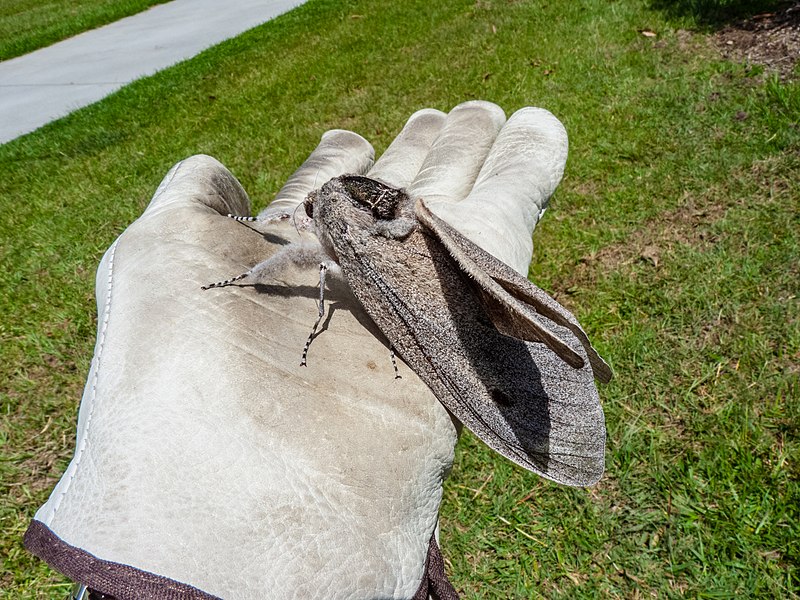Giant Wood Moth Facts
- This dazzling giant example of Lepidoptera most frequently goes by the perfectly apt common name of the Giant Wood Moth. For the moment, though, this magnificent creation of the efforts of Nature and evolution has no other accepted common name.
- Scientific professionals, however, typically refer to this marvelous invertebrate by its formal scientific name. That, though, represents a bit more of a challenge to pronounce. That’s because the scientific name for the creature is that of Endoxyla cinereus.
- The Prussian-born entomologist, Johann Gottlieb Otto Tepper made the first known recognition of it as a separate and distinct species. This scientifically noteworthy accomplishment further occurred in 1890. At that time, though, he name it differently.
- Regardless of which term one employs when referring to it, though, it represents an awesome sight to behold. That holds true due to its sheer mass. While the Giant Atlas Moth is the largest moth in wingspan, this insect remains the heaviest of its kind.
- Humans rarely see the Giant Wood Moth, but evidence indicates it has a sufficient and stable population base. This also seems to hold true throughout the entirety of its native range. The IUCN, therefore, presently has no listing for it on its Red List.
- The insect nevertheless must be considered to be facing several threats to its existence. Habitat loss due to human expansion remains a threat to it. Its greatest danger, though, perhaps comes in the form of ongoing climate change, like numerous other species.
Related Articles
Giant Wood Moth Physical Description
The very name of the Giant Wood Moth gives a good indication of its most noteworthy physical characteristic. That notable trait, however, only applies to roughly half the population. That’s because this species exhibits a strong degree of seuxal dimorphism.
More specifically, the females attain roughly twice the size of their male counterparts. The larger females reach an impressive average wingspan measuring approximately 9.06 in (23 cm). The wingspan of the males averages barely half of that, in most specimens.
Likewise, the sheer mass of the females also averages roughly twice that of the smaller males of the species. Some females, in point of fact, attain a measured mass of as much as 1.06 oz (30 g)! Although that may not sound like much to many people, for a moth it’s huge.
Otherwise, however, the two genders remain virtually identical in outward appearance. Both sexes display the same overall pattern of coloring. The forweings typically show a light or dark gray. The hindwings, meanwhile, usually display a light or medium brown.
The body of the Giant Wood Moth, however, presents a striking visual pattern. This typically displays a dark brown background, with thin, light brown stripes appearing across the body horizontally. The rear tip of the body, though, also generally presents as light brown.
- Kingdom: Animalia
- Phylum: Arthropoda
- Class: Insecta
- Order: Lepidoptera
- Family: Cossidae
- Genus: Endoxyla
- Species: E. cinereus
Giant Wood Moth Distribution, Habitat, and Ecology
The fabulous Giant Wood Moth evolved as native to a very limited region of the world. For the moment, furthermore, no evidence exists that it ever appeared anywhere else. The region of the world where it appears, however, will likely come as no surprise.
That’s due to the fact that this arthropod evolved as mainly endemic to the continent of Australia. Even there, though, the wondrous invertebrate only inhabits a few dozen, widely scattered areas of the vast continent, including Queensland, and New South Wales.
A small population, however, also appears on the island of New Zealand. In each of the lamentably few areas in which it appears, though, it displays decided preferences for its choice of habitat type. It only appears in regions containing quantities of eucalyptus trees.
The vast majority of individuals, in fact, spend their entire lives on and around individual trees! These trees serve as home to the larvae, after the eggs laid on the trees hatch. Once these have done so, the larvae quickly bore into the bark of the host tree.
There, furthermore, the larvae spend up to an entire year burrowing tunnels through the bark, feeding. These tunnels tend to enlarge as they progress, as the larvae do. Once they reach the caterpillar stage, they emerge, and lower themselves to the ground.
There, the caterpillar form of the Giant Wood Moth feeds on the roots of nearby plants. Once they attain adulthood, however, they only live a few more days. Indivduals also do not feed once they reach adulthood. Matue females lay their eggs, and die soon after.
Species Sharing Its Range
Check out our other articles on 4 Magnificent Malaysian Insects, Purple Frog, Macquarie Island, Platypus, Parrot’s Beak, New Zealand Giraffe Weevil, Anegada ground iguana, Hyacinth Macaw

